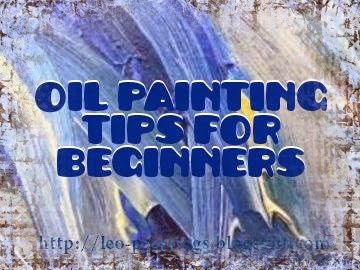Oil paints are extremely versatile. They can be used thickly in impasto or extremely thinly in glazes; they can be opaque or transparent. Here are a few tips to help you get the most from your oils.
Use the best quality of oil paint you can afford. These can be expensive but are well worth it! Start with the primary colors first, and buy a tube of good quality paint whenever you can.
To spare the expensive paint along, use student quality for under-paintings and initial layers.
Tip 1:
Always lay your oil paints out on your palette in the same order so that, with time, you'll be able to pick up a bit of a colour instinctively.
Tip 2:
The proportion of oil medium (not turps thinner) should be increased for each subsequent layer in an oil painting – known as painting 'fat over lean' – because the lower layers absorb oil from the layers on top of them. If the upper layers dry faster than the lower ones, they can crack.
Tip 3:
Avoid using Ivory Black for an underpainting or sketching as it dries much slower than other oil paints.
Tip 4:
Pigments containing lead, cobalt, and manganese accelerate drying. They can be mixed with other colours to speed up drying and are ideal for under layers. (Student-quality paints usually contain cheaper alternatives to these pigments, generally labelled hues.)
Tip 5:
Use linseed oil for an underpainting or in the bottom layers of any oil painting done wet-on-dry as it dries the most thoroughly of all the oils used as mediums.
Tip 6:
Avoid using linseed oil as a medium in whites and blues as it has a marked tendency to yellow, which is most notable with light colours. Poppy oil is recommended for light colours as it has the least tendency to yellow (although it does dry slower).
Tip 7:
Don't dry your oil paintings in the dark. This may cause a thin film of oil to rise to the surface, yellowing it. (This can be removed by exposure to bright daylight.)
Tip 8:
If, as the paint on your palette dries it forms a lot of wrinkles, too much oil (medium) has been added.
Tip 9:
If you're not sure whether a bottle of mineral or white spirits is suitable for oil painting, put a tiny quantity on a piece of paper and let it evaporate. If it evaporates without leaving any residue, stain, or smell, it should be fine.
Tip 10:
If you want to clean away a layer of oil paint or oil varnish, use alcohol, which is a powerful solvent.
Tip 11:
Remember that you can paint with oils without using solvents, using brush pressure to spread the paint out thinly, only oil as a medium and to rinse your brush.
Tip 12:
Don’t use linseed oil when mixing with whites, blues and light colors as it has a yellow hue. Use poppy oil instead when mixing with light colors. Linseed oil is ideal for the under-painting, as it helps the paint dry much faster.
Tip 13:
Use alcohol or turpentine to remove layers when needed. Never use alcohol to clean a dried painting, as it will remove or smudge the paint.
Tip 14:
Never use acrylic on top of oil paint acrylic does not adhere well to oil paint. After a while, the paint will flake or peel.
Tip 15:
Never use pure black many experienced artists will agree. Use dark blues or mixed colors instead, such as phthalo blue mixed with alizarin crimson.
Tip 16:
Cleaner turpentine in the brush jar use a piece of wire mesh or spring that fits in the bottom of your brush jar. This will help clean your brushes, without agitating the residue which sits at the bottom.
Tip 17:
Use brush strokes to enhance a painting brush strokes can bring out forms and emphasize certain areas. As a general rule, use thickly applied paint and texture to highlight parts of a composition.
Tip 18:
Rotate turps and mineral spirits use three jugs, one for the used mineral spirits
(A), one for all the paint residue
(B), and the other for clean mineral spirits
(C). Let the paint settle in jug A, and pour the clean mineral spirits into jug C. Then, pour the residue into jug B. This will help your mineral spirits or turpentine go much further.
Top 19:
Avoid using colors directly from the tube for much of the composition (such as backgrounds). Mix them accordingly. Use pure colors for highlights and things you want to emphasize. This is a personal preference and of course is not a “rule”.
Top 20:
To always keep your palette clean, use wax paper. Wrap it around the palette and tape it in place. Dispose of the wax paper after each use. This is much easier than having to clean a painting palette after each painting session.
Learn painting techniques and how to paint first, then break the rules later. This is a basic rule I learned in art school, and is one I believe all artists should follow.
Use the best quality of oil paint you can afford. These can be expensive but are well worth it! Start with the primary colors first, and buy a tube of good quality paint whenever you can.
To spare the expensive paint along, use student quality for under-paintings and initial layers.
Tip 1:
Always lay your oil paints out on your palette in the same order so that, with time, you'll be able to pick up a bit of a colour instinctively.
Tip 2:
The proportion of oil medium (not turps thinner) should be increased for each subsequent layer in an oil painting – known as painting 'fat over lean' – because the lower layers absorb oil from the layers on top of them. If the upper layers dry faster than the lower ones, they can crack.
Tip 3:
Avoid using Ivory Black for an underpainting or sketching as it dries much slower than other oil paints.
Tip 4:
Pigments containing lead, cobalt, and manganese accelerate drying. They can be mixed with other colours to speed up drying and are ideal for under layers. (Student-quality paints usually contain cheaper alternatives to these pigments, generally labelled hues.)
Tip 5:
Use linseed oil for an underpainting or in the bottom layers of any oil painting done wet-on-dry as it dries the most thoroughly of all the oils used as mediums.
Tip 6:
Avoid using linseed oil as a medium in whites and blues as it has a marked tendency to yellow, which is most notable with light colours. Poppy oil is recommended for light colours as it has the least tendency to yellow (although it does dry slower).
Tip 7:
Don't dry your oil paintings in the dark. This may cause a thin film of oil to rise to the surface, yellowing it. (This can be removed by exposure to bright daylight.)
Tip 8:
If, as the paint on your palette dries it forms a lot of wrinkles, too much oil (medium) has been added.
Tip 9:
If you're not sure whether a bottle of mineral or white spirits is suitable for oil painting, put a tiny quantity on a piece of paper and let it evaporate. If it evaporates without leaving any residue, stain, or smell, it should be fine.
Tip 10:
If you want to clean away a layer of oil paint or oil varnish, use alcohol, which is a powerful solvent.
Tip 11:
Remember that you can paint with oils without using solvents, using brush pressure to spread the paint out thinly, only oil as a medium and to rinse your brush.
Tip 12:
Don’t use linseed oil when mixing with whites, blues and light colors as it has a yellow hue. Use poppy oil instead when mixing with light colors. Linseed oil is ideal for the under-painting, as it helps the paint dry much faster.
Tip 13:
Use alcohol or turpentine to remove layers when needed. Never use alcohol to clean a dried painting, as it will remove or smudge the paint.
Tip 14:
Never use acrylic on top of oil paint acrylic does not adhere well to oil paint. After a while, the paint will flake or peel.
Tip 15:
Never use pure black many experienced artists will agree. Use dark blues or mixed colors instead, such as phthalo blue mixed with alizarin crimson.
Tip 16:
Cleaner turpentine in the brush jar use a piece of wire mesh or spring that fits in the bottom of your brush jar. This will help clean your brushes, without agitating the residue which sits at the bottom.
Tip 17:
Use brush strokes to enhance a painting brush strokes can bring out forms and emphasize certain areas. As a general rule, use thickly applied paint and texture to highlight parts of a composition.
Tip 18:
Rotate turps and mineral spirits use three jugs, one for the used mineral spirits
(A), one for all the paint residue
(B), and the other for clean mineral spirits
(C). Let the paint settle in jug A, and pour the clean mineral spirits into jug C. Then, pour the residue into jug B. This will help your mineral spirits or turpentine go much further.
Top 19:
Avoid using colors directly from the tube for much of the composition (such as backgrounds). Mix them accordingly. Use pure colors for highlights and things you want to emphasize. This is a personal preference and of course is not a “rule”.
Top 20:
To always keep your palette clean, use wax paper. Wrap it around the palette and tape it in place. Dispose of the wax paper after each use. This is much easier than having to clean a painting palette after each painting session.
Learn painting techniques and how to paint first, then break the rules later. This is a basic rule I learned in art school, and is one I believe all artists should follow.


No comments:
Post a Comment